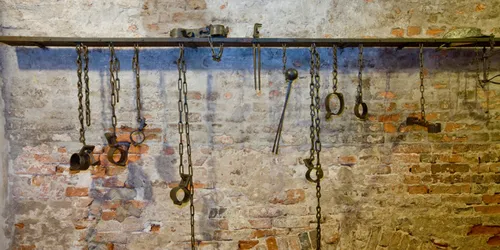The perforated prisons and rock passages in Nuremberg
Below the town hall, 15 prison cells show how prisoners fared in the 14th century. In the Middle Ages, the extensive underground tunnels were also used as a brewery for Nuremberg beer.

Nuremberg's hole prisons and rock passageways: a journey into the underworld
Have you ever been to Nuremberg? But you certainly haven't seen the city from below. In the Franconian city of 500,000 inhabitants, there are several opportunities to dive down. For example, on a visit to the infamous hole prisons.
The infamous hole-in-the-wall prisons in Nuremberg
When the town hall was built in 1322, a remand prison was planned in the vaulted cellar, where suspects and defendants were held until their sentences were passed. Today, visitors can see for themselves the terrible prison conditions on daily guided tours: Each cell was just two metres by two metres and completely dark. Also down here is the former prison guard's flat - and the torture chamber. Stretching instruments and choking irons still hang here today - and send a shiver down your spine at the thought of how prisoners were maltreated here in the past. The prison holes are therefore only suitable for children to a limited extent - on the advice of the operator, they should be at least ten years old to avoid being creeped out.
The historic rock corridors of Nuremberg
Just 300 metres from the Hole Prisons is a second underground excursion destination: the Felsengänge have just as exciting a history as the Hole Prisons, but are less scary and therefore also suitable for children under the age of ten. This is a tunnel system of narrow corridors that runs beneath Nuremberg's Old Town. In the 14th century, it was used to ferment and store beer. At that time, there were around 40 breweries in the small city. A law required that everyone who brewed beer had their own cellar. This is how the extensive rock cellars, spread over several storeys, came into being. Today they measure more than 20,000 square metres. This makes them the largest labyrinth of rock cellars in the whole of southern Germany. Later, during the Second World War, the underground tunnels protected many people during the bombing of Nuremberg. Today, a small part of the rock corridors is once again used to store beer. However, it is mainly guided tours that take place in the huge labyrinth of cellars.
Guided tours of the Nuremberg rocky passages
You should definitely try the guided tour "Red beer in deep cellars". It's all about beer, of course. A guide will tell you everything you need to know about Nuremberg's underground brewing tradition - including a small beer tasting in the cellar. The tour ends in the Bierothek with another tasting of Nuremberg red beer. It's best to make sure you have a good foundation in your stomach beforehand. By the way: children are also allowed to take part in the tour, but of course they will only be served non-alcoholic drinks.
Child-friendly treasure hunts and exciting night-time tours
For children, however, we recommend the "Treasure Hunt" adventure tour : together with a guide, they embark on an exciting search for a long-lost treasure. The " Let's meet for a Walk in the Dark" tour is even more exciting, especially for adults. Equipped with a hard hat and torch, you will trudge through pitch-black cellar corridors while the guide tells fascinating myths and legends about the city of Nuremberg and its rocky passages.
Important information and how to get to the Hole Prisons and Rock Corridors
Current information, admission prices and opening times can be found here.
From Nuremberg Central Station, you can reach your destination in just 17 minutes on foot. Leave the station through the north exit via the station square and turn right. After 180 metres, turn left past the Frauentorturm tower into Königstraße. Follow this street for 600 metres through the old town past the Lorenzkirche church to the Museumsbrücke bridge. Cross the Pegnitz here and continue straight ahead onto Nuremberg's main market square. Cross the Hauptmarkt square and turn slightly right at the Schönen Brunnen fountain onto Hauptmarkt street. After 140 metres you will reach Rathausplatz. The destination is on your right at number 2.
Arrival
Rathausplatz 2
90403 Nuremberg
Nürnberg Hbf
Our tip: Please make sure to check your train connection and the expected capacity before you start your journey.